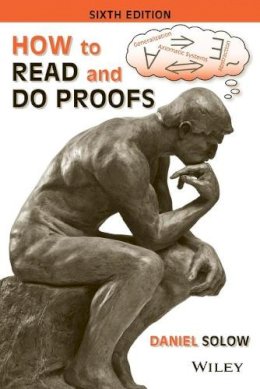
Stock image for illustration purposes only - book cover, edition or condition may vary.
How to Read and Do Proofs: An Introduction to Mathematical Thought Processes
Daniel Solow
€ 95.07
FREE Delivery in Ireland
Description for How to Read and Do Proofs: An Introduction to Mathematical Thought Processes
Paperback. This text makes a great supplement and provides a systematic approach for teaching undergraduate and graduate students how to read, understand, think about, and do proofs. Num Pages: 336 pages, illustrations. BIC Classification: PBCD. Category: (P) Professional & Vocational. Dimension: 155 x 228 x 13. Weight in Grams: 388.
This text makes a great supplement and provides a systematic approach for teaching undergraduate and graduate students how to read, understand, think about, and do proofs. The approach is to categorize, identify, and explain (at the student's level) the various techniques that are used repeatedly in all proofs, regardless of the subject in which the proofs arise. How to Read and Do Proofs also explains when each technique is likely to be used, based on certain key words that appear in the problem under consideration. Doing so enables students to choose a technique consciously, based on the form of the problem. ... Read more
This text makes a great supplement and provides a systematic approach for teaching undergraduate and graduate students how to read, understand, think about, and do proofs. The approach is to categorize, identify, and explain (at the student's level) the various techniques that are used repeatedly in all proofs, regardless of the subject in which the proofs arise. How to Read and Do Proofs also explains when each technique is likely to be used, based on certain key words that appear in the problem under consideration. Doing so enables students to choose a technique consciously, based on the form of the problem. ... Read more
Product Details
Format
Paperback
Publication date
2013
Publisher
John Wiley & Sons Inc United States
Number of pages
336
Condition
New
Number of Pages
336
Place of Publication
New York, United States
ISBN
9781118164020
SKU
V9781118164020
Shipping Time
Usually ships in 4 to 8 working days
Ref
99-2
About Daniel Solow
Daniel Solow is a professor of management for the Weatherhead School of Management at Case Western Reserve University. His research interests include developing and analyzing optimization models for studying complex adaptive systems, and basic research in deterministic optimization, including combinatorial optimization, linear and nonlinear programming. He has published over 20 papers on both topics.
Reviews for How to Read and Do Proofs: An Introduction to Mathematical Thought Processes
"The instructional material is to the point, with well-considered examples and asides on common mistakes. Good examples of the author's thoughtfulness appear in the discourses on pp. 5-6 of identifying the hypothesis and conclusion when they are not obvious, on pp. 28-29 regarding overlapping notation, and on pp. 190-191 of the advantages and disadvantages of generalization." (Zentralblatt MATH 2016)
